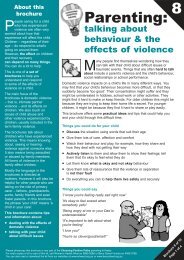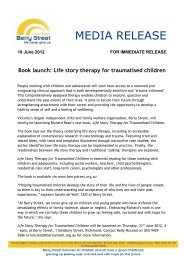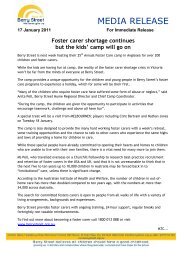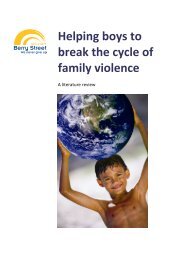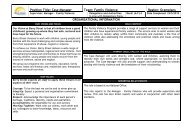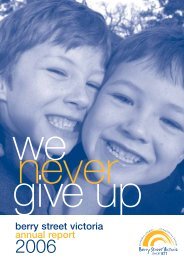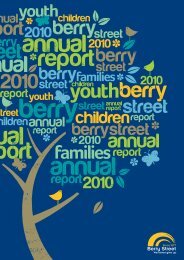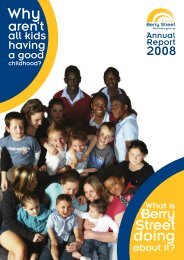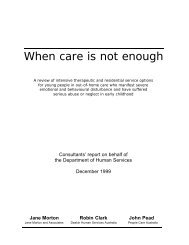Take Two - Third Evaluation Report More than Words ... - Berry Street
Take Two - Third Evaluation Report More than Words ... - Berry Street
Take Two - Third Evaluation Report More than Words ... - Berry Street
Create successful ePaper yourself
Turn your PDF publications into a flip-book with our unique Google optimized e-Paper software.
<strong>Take</strong> <strong>Two</strong> staff Raeleen McKenzie and Dr Chris Tanti<br />
along with Dr Jenny Dwyer are coaching staff on the<br />
model and a new contract was signed in 2009 to provide<br />
training for a further two years. Although the Just Care<br />
model stands separate from other aspects of the <strong>Take</strong><br />
<strong>Two</strong> role, it builds on the theoretical and therapeutic<br />
approach of <strong>Take</strong> <strong>Two</strong> and applies understanding of the<br />
theories to a different context.<br />
3.7 <strong>Take</strong> <strong>Two</strong> Infant Mental Health<br />
Project<br />
<strong>Take</strong> <strong>Two</strong> holds an unequivocal stance on the pivotal<br />
opportunities and heightened risks associated with<br />
infancy. Infancy is a time of great vulnerability and also<br />
of great promise, the greatest growth and organisation<br />
in the brain occurs before the age of three years and the<br />
template for future relationships is established in early<br />
relationships. Development moves along at an amazing<br />
pace from the complete helplessness of the newborn to<br />
the relative physical and emotional sophistication of the<br />
three-year-old.<br />
The developmental tasks of infancy are enormous and<br />
acute distress and disruption at this time can have farreaching<br />
consequences for the infant and their carer(s).<br />
<strong>Take</strong> <strong>Two</strong> contends that early, effective interventions at<br />
this time can alleviate distress and facilitate attachment<br />
to a parent or carer, preventing or reducing long-term<br />
dif culties. The fundamentals of attachment theory<br />
indicate that the primary attachment relationships are<br />
usually established within the rst three years of life,<br />
and therefore systemic and therapeutic interventions<br />
in the parent–child or carer–child relationship can<br />
maximise the formation of a secure attachment and the<br />
resilience that this brings to the child. This can reduce<br />
the likelihood of signi cant developmental disruptions<br />
and the attendant effects. Yet despite all this, there are<br />
few referrals of infants and young children to <strong>Take</strong> <strong>Two</strong>.<br />
There are substantial numbers of child protection<br />
clients less <strong>than</strong> three years of age in Victoria (DHS,<br />
2002c), and so can be assumed to have suffered the<br />
trauma of their abuse andneglect. There are, however,<br />
no speci cally targeted therapeutic services focused on<br />
their recovery. Both <strong>Take</strong> <strong>Two</strong> and CAMHS are funded to<br />
see infants but neither receives many referrals. There<br />
are many reasons for this, not least a lack of awareness<br />
of the impact of trauma and disrupted attachment on<br />
infants in both therapeutic and child protection staff,<br />
and the immediacy of responsiveness required by child<br />
protection staff and other professionals.<br />
In February 2007 <strong>Take</strong> <strong>Two</strong> decided that a response to<br />
the twin facts of low infant referrals and the missed<br />
opportunity that this represents for intervention and<br />
prevention was necessary. An Infant Mental Health<br />
Project aiming to address some of the barriers to<br />
therapeutic service delivery to infants was formulated<br />
and trialled in the Southern Metropolitan region.<br />
The aim of this Infant Mental Health Project is to<br />
increase the capacity of Southern Metropolitan region<br />
<strong>Take</strong> <strong>Two</strong> and child protection staff in understanding and<br />
working with the mental health needs of child protection<br />
clients less <strong>than</strong> three years of age. The approach was<br />
to provide fortnightly secondary consultation by <strong>Take</strong><br />
<strong>Two</strong> to the High Risk Infant Team in the Southern<br />
Metropolitan region.<br />
22<br />
Six consultation sessions were held in 2007, with ve<br />
occurring fortnightly over September and October and<br />
one in December. Sessions in November and December<br />
were cancelled for various operational reasons. All<br />
sessions were well attended by workers in the High Risk<br />
Infant Team. Consultations were led by senior <strong>Take</strong> <strong>Two</strong><br />
staff.<br />
As expected, a high need for infant mental health input<br />
was found. Infants were described as considerably<br />
distressed. Child protection staff were task focused,<br />
particularly on their mandate to investigate and<br />
intervene to stop the child being exposed to harm from<br />
abuse and neglect. The sessions were often used to<br />
consider what capacities were required in the parent<br />
to provide adequate care for the infants. Because of<br />
a background of distress and disruption, as well as<br />
some developmental delays, all infants presented for<br />
discussion had special needs that would have challenged<br />
most parents or carers.<br />
Fortnightly sessions were overly ambitious and workers<br />
experienced con ict in their desire to attend amidst the<br />
demands of their demanding workloads. Three referrals<br />
were made to <strong>Take</strong> <strong>Two</strong> for ongoing therapeutic work.<br />
Child protection workers reported that they found the<br />
consultations useful and wanted them to continue.<br />
They requested that the consultations follow a format<br />
of education on speci c topics that would then guide<br />
case discussion.<br />
The model of consultation is being documented in the<br />
<strong>Take</strong> <strong>Two</strong> Practice Framework and implementation<br />
across the program via training and supervision has<br />
been expanded in 2009.<br />
3.8 Neuropsychology service and<br />
research at <strong>Take</strong> <strong>Two</strong><br />
The neuropsychology service to the <strong>Take</strong> <strong>Two</strong> program<br />
has been operating since May 2005. This specialist<br />
service has been available to all <strong>Take</strong> <strong>Two</strong> regions<br />
and to a limited extent to the Secure Welfare Service.<br />
Neuropsychological assessments and feedback have been<br />
provided by Victoria University Doctor of Psychology–<br />
Clinical Neuropsychology trainees under the supervision<br />
of Dr Alan Tucker (Clinical Neuropsychologist). Between<br />
2005 and 2008 a total of 50 children and adolescents,<br />
ranging in age from 4 to 17 years, were formally<br />
assessed by nine doctoral trainees. These trainees were<br />
typically in their nal year of clinical neuropsychology<br />
training, had had several prior clinical placements, and<br />
were on 40-day placements at <strong>Take</strong> <strong>Two</strong> (usually two<br />
days a week).<br />
The neuropsychology assessments are conducted in a<br />
developmental framework of the emerging cognitive,<br />
emotional and behavioural skills of the children. In<br />
view of its importance for age appropriate and adaptive<br />
functioning at home, school, therapy, and in the wider<br />
community, these assessments have usually focused<br />
on cognitive functioning. Accordingly, the aim of the<br />
neuropsychology assessment is to produce a pro le of<br />
the cognitive abilities of the child. The pro le typically<br />
includes the vital cognitive skills of visual spatial ability,<br />
visual perception, receptive and expressive language,<br />
information processing speed, verbal memory, visual<br />
memory, verbal learning, attention, and executive<br />
cognitive functioning. Such assessments go well<br />
beyond the more limited assessment of cognitive<br />
function as re ected in an IQ score. An important part<br />
Frederico, Jackson, & Black (2010) “<strong>More</strong> <strong>than</strong> <strong>Words</strong>” – <strong>Take</strong> <strong>Two</strong> <strong>Third</strong> <strong>Evaluation</strong> <strong>Report</strong>, La Trobe University, Bundoora, Australia





